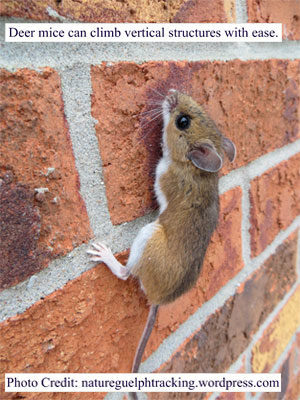You may never have thought of mice as acrobats before, but we think after reading this article you’ll be sure to change your mind. Most people are surprised to learn how effectively mice can climb, even straight up a well or other surface, given the right conditions.
Perhaps, you are curious enough to inquire about such hot topics as “Can mice climb stairs, walls, and ceilings? Can they climb up my home’s exterior and get into my home?” We provide you with a due reward for your inquisitiveness just below.
Mice are wild creatures, remember. They have survival instincts and extremely physically adept little bodies. They know how to use their God-given skills (including climbing skills) to the max. Read on to learn both their abilities and their limitations.
[toc]
Can Mice Climb Walls and Ceilings?
Ah, yes. Mice are master climbers. They have been reported scaling both interior and exterior walls with ease, doing long-distance tight rope climbs on wires and pipes, and even dangling from the ceiling.
Did you ever wonder how mice manage to get into attics, despite the attic being high off the ground? Or how do they get up from the crawl space and into the house? And when you hear the pitter patter of little feet inside your walls, don’t think that they only walk along floor level.
It’s not by magic that mice so often wind up in your attic and spread from there into the rest of the house. It’s by climbing up trees, siding, bricks, stucco or any sufficiently porous surface or one with little nooks and crannies in it.
Click this link to learn how to get rid of mice in the attic and how to prevent them from getting there to being with.
What About Stairs?
Stairs are made for climbing, and although mice feet are far too small for them to use stairs the “normal” way, they use them nonetheless.
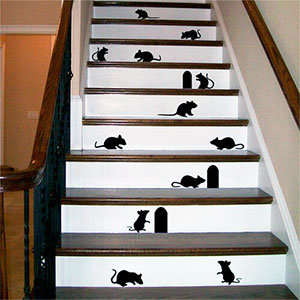 A mouse can climb wood, concrete, or carpeted stairs with amazing determination, speed, and stealthiness.
A mouse can climb wood, concrete, or carpeted stairs with amazing determination, speed, and stealthiness.
They can run up the face and foot of each stair, climb up along the edge of the stairwell on a piece of trim, or even climb up on the hand railing.
You really can’t stop mice from climbing stairs because making steps out of slippery, non-porous materials would create a slip-and-fall hazard for humans, not just for mice. And it doesn’t matter whether it’s indoor or outdoor stairs, small or large steps, or long versus short staircases – mice can climb it all.
What Can They Climb?
What materials and objects specifically are mice capable of climbing? I’m glad you asked!
If a surface is too smooth, mice won’t be able to climb it. That’s why bucket traps work on mice – so long as the bucket is smooth on the inside and at least a foot high so the mice can’t jump out.
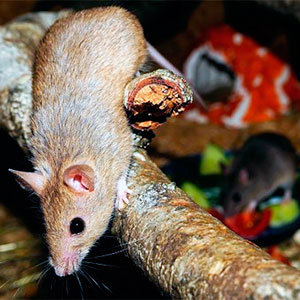 Here are some examples of what mice can climb:
Here are some examples of what mice can climb:
- Vinyl, cedar, redwood, aluminum, and all other varieties of siding.
- Brick, stucco, rock, and other building facade materials.
- Metal surfaces, unless the metal is too smooth and too tall.
- Drywall, painted or unpainted.
- Trees and branches overhanging your house.
- Most forms of plastic.
- Wood furniture.
- Gutter downspouts.
The fact is, the majority of materials out of which your home is built are very “climb-able” to mice. That’s true of both indoor and outdoor surfaces.
It would be impossible to make your home “climb proof” against mice, so that’s not really a possible mouse prevention method. There are ways you can minimize the chances they’ll be climbing around on your property or find a way in, however. More on that in the last section of this article.
Can Mice Get on Countertops?
Yikes! Is that a mouse running across my kitchen counter top? Perhaps, you’ve had that experience in the past and you’re wondering how the mouse ever got up there to begin with.
Mice often get into kitchens (and bathrooms) through tiny holes in the walls where pipes or electric wiring enter, maybe behind the stove or under the kitchen or bathroom sink.
The mouse may hide out in a cabinet and then climb inside of it till it finds a way into an open drawer (even a crack open), from where it gets on the counter top. Or, it may simply climb right up the outside of the counter, using tiny pores and crevices as foot holds.
How Do Mice Climb?
How do mice manage to climb? In particular, how do they climb up vertically?
The full answer would enter into an anatomical description of a mouse’s body, but we forego.
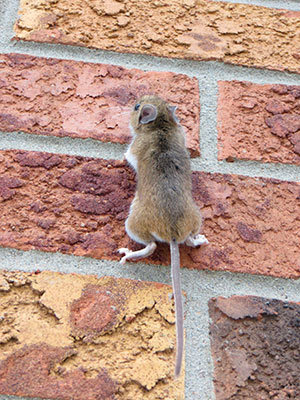 Here are 4 key reasons mice are such good climbers:
Here are 4 key reasons mice are such good climbers:
- They have tiny claws that can find and fit easily into minute cracks, crevices, and pores in a wall, ceiling, or other object.
- They are very strong for their size and able hold on tight, both vertically and horizontally.
- Mice can stretch their bodies so as to lay them flat against a wall or other surface, helping them to not fall off.
- Mice use their tails to adjust for balance while climbing.
Field Mice
Field mice will climb up trees, rocks, fences, tomato plants, and almost anything else in the field, yard, or garden if they feel the need and get the chance.
 By cutting back weeds, grass, and other greenery near the outer perimeter of your home, you discourage field mice from nesting near your exterior walls. And that greatly reduces the chance they’ll try to climb them.
By cutting back weeds, grass, and other greenery near the outer perimeter of your home, you discourage field mice from nesting near your exterior walls. And that greatly reduces the chance they’ll try to climb them.
But what if mice have already gotten inside of your walls? Click here to learn how to get rid of mice in walls as fast as possible and with the least possible expense.
House Mice
Most house mice are the same species as field mice anyway or a very closely related one. There really isn’t any significant difference in mice’s climbing ability based on whether they are field mice or house mice.
Mice can generally only climb up a foot or so vertically on a surface like drywall or relatively smooth rock or metal. But by taking advantage of any edging, bumps, holes, wires, pipes, or bulky objects on the wall, they can climb much higher. And there’s no real limit to high they can climb on more thoroughly porous, “gappy” walls.
House mice will climb up walls sometimes, especially along trim boards or anywhere there’s a handy to toe hold available. They will find it easier, however, to climb up on the inside of your walls since there are more objects to climb on there, such as wires, pipes, nails, outlet boxes, and batts insulation.
Click on the link to find out how to keep mice out of your house to begin with.
How to Stop
To stop mice from climbing walls, the first tactic should simply be to get rid of them if they’re already inside your home. Click the link to find out ways to catch a mouse in your house.
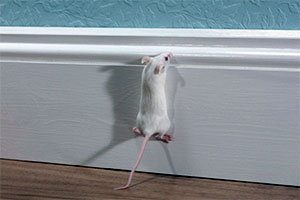 But here are some other tips to use to reduce the risks that mice will climb in or into your home:
But here are some other tips to use to reduce the risks that mice will climb in or into your home:
- Keep your weeds and foliage down in your yard, especially along the building’s perimeter. And remove all clutter and junk from the yard where mice might hide.
- Eliminate entry points. Caulk holes, cover them with boards, or stuff steel wool into them. Mice hate steel wool because it hurts their paws and teeth.
- Seal off the ends of open pipes with steel mesh. Do the same with any vents coming out of your walls or roof.
- Plant spearmint plants along the outside of your house. Mice hate the smell of mint and will tend to avoid it if more attractive non-minty areas are readily available.

Another 4 Fragrant Plants to Repel Mice - Put specially designed cones or smooth plastic circles around your exterior pipes and cords (where it’s not an electrical/fire hazard), right where they enter the building. This can block mice’s climbing routes.
You really can’t de-claw your mice or eliminate all climb-able surfaces. You could minimize them to a degree, however, and take measures to prevent a mouse infestation and eradicate mice already in your home.
Mice are smart, agile climbers who never miss a good entry point just because it’s above ground or up a wall, if they can help it. When mouse-proofing your building, don’t underestimate mice’s climbing abilities, or they could unpleasantly surprise you by showing up on your counter top, inside your wall, or even clinging to a hole in your ceiling!

